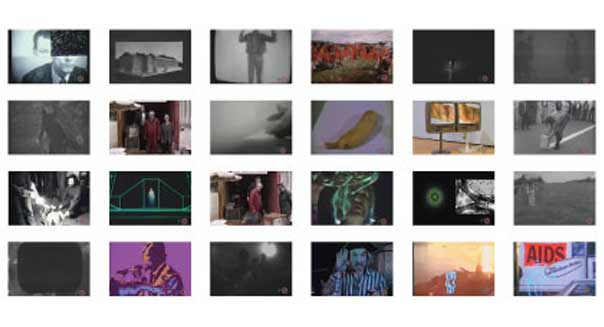《德國錄像藝術特展》
RECORD > AGAIN! – 40jahrevideokunst.de – Teil 2
ꕥ 展期 Duration:2011/02/08 – 2011/03/06
ꕥ 地點 Venue:台北數位藝術中心
ꕥ 地址 Address:111台北市士林區福華路180號;近捷運淡水線芝山捷運站二號出口
ꕥ 策展理念
「再錄一次!德國錄像藝術40年 – 第二部分」一如第一部份,第二部分也是探索德國從六○年代與七○年代之濫觴期,到二十一世紀初的錄影藝術歷史之演變。這兩項計畫皆是由德國聯邦基金會所推動。就今天的角度而言,從事錄像藝術研究首要的任務是讓過去幾十年來所製作的錄影資料可以再度呈現出來。其中許多作品長年塵封在博物館的貯藏間以及藝術家工作室,由於技術性的原因而無法再播放,因此而被人所遺忘。這些帶子有一吋、半吋或是四分之一吋的規格,而且又錄在奇怪的正方形甚至五角形的卡帶裡,可以播放他們的器材都已經絕跡或是壞了。而且錄影帶本身也幾乎是無法使用,因為帶子已經開始分解與沾黏。為了防止這種情況繼續惡化,卡斯魯爾ZKM視覺媒體研究所於2004年設立了舊型錄影系統的修復中心。目前為止已經收集並修復了相當龐大的舊型錄影器材,跟新的數位技術結合之後,讓六○年代到八○年代之間50餘種過時的錄影規格能夠重新跟大家見面,並且以高品質的數位化技術為後世流傳下去。
發現、拯救與重建「再錄一次!」這項計畫現在以實體的展覽、內容豐富的目錄以及DVD珍藏版,介紹過去四十年來50餘件代表性作品,這些作品正反映了德國錄影藝術創作多樣化的面貌與其歷史的演變。起初造型藝術家利用錄影這個新的媒材去紀錄他們的作品,或是用來擴展創作的觀點,譬如:烏利希‧呂科林、克勞斯‧林克、F.E.華特、萊納‧盧騰貝克或是克勞斯‧柏姆爾。包括約瑟夫‧波依斯於1972年的第五屆文件大展中的著名拳擊賽挑戰、沃爾夫‧卡稜由六個螢幕組成的「羊」的作品之重建,原作最後一次是在1976年展出。萊納‧盧騰貝克1974年著名的作品「擋住錄影畫面一部分的物體」,則是以比大家至今知道的影片的三倍長呈現出來;而同樣是出自1974年的克勞斯‧柏姆爾之「我們用捲心菜的紅作畫」,本來已是肢離破碎,透過繁複修補不同收藏的版本後,完整還原了本來面貌。此外,還展出蓋瑞‧蘇姆與克勞斯‧林克以及烏利希‧呂科林在電視畫廊系列之中的創作,另外一件是1977年的關於安娜‧歐佩曼的紀錄作品以及巫蘇拉‧薇菲絲的雙頻道作品。
從藝術家的錄影到錄影藝術家像是巫莉克‧羅森巴哈與克勞斯‧馮布魯赫的一件1977年鮮為人知的表演藝術作品就在此展覽之中展出。有兩件錄影作品讓我們再度發現1976年過逝的沃夫岡‧史托希勒,他在70年代初的加州錄像藝術界扮演重要角色,但是其作品之後被人完全遺忘。另外有霍佳‧蘇凱一件首次完整出現的作品「回顧1982年」跟他一件比較早的「清涼池」版本。還有至今未發表過的1981年在柏林天波壇舉行的「天才業餘者節慶」之錄影資料與一部當代的作品「加速的小雞」。
錄影行動藝術以及錄影工作坊1970年代懷有烏托邦理想的社會活動也發現了錄影媒介,開始把它用來當作啟蒙、紀錄與宣傳的工具。從佛萊堡到漢堡許多獨立團體把錄影用來作為政治與社會的媒介。由此也產生了獨立電視與自己所屬的藝術頻道之願景。此展中由賀伯‧舒馬赫與電視知識小組所做的德國早期閉路電視作品「神奇的鏡子」,此影片被當作錄影紀錄文獻,並加上38年後重新再做一次的錄影文獻,同時播出。此外還有佛萊堡的媒體工作坊所策劃的活動以及「藝術頻道」的獨立電視製作節目、「我們的電視台」以及「錄影藝術雜誌VAMP」。由米夏艾拉‧布榭與葛特‧孔拉徳1985年採訪葛瑞琴‧杜曲科的紀錄影片,在加上新的現在訪問材料做成的裝置作品。在此展中,藝術史上轟動一時之大事是一部窄電影膠片記錄,顯示一台半吋規格的錄影設備,1981年米夏愛爾‧摩爾格內就是以此設備在前東德紀錄下一場表演藝術,不過錄影帶本身已經下落不明。在展覽中還可以看到1980年由沃爾夫岡.卡棱與A.R.彭克在東柏林策劃的「小心攝影機」的錄影行動藝術、約可.赫若德1988年的一個錄影物件作品之重建,以及盧次.丹貝克1984年,同樣是在前東德製作的影片「海克力斯」。錄影影片的技術條件變的簡單之後,遂產生了「錄影散文」這種新的錄影類型,譬如:笛妮‧梅樂‧馬克薇茲的「關於威廉‧萊西 ─ 小人物萬歲」以及蘇珊妮‧歐芙特琳恩的妮可像。在這次的展覽之中,絕大多數的作品是用今天的器材設備所放映。
藝術指導:彼得‧威柏
總策劃:克里斯多弗‧布拉澤
*本文翻譯自「再錄一次!德國錄像藝術40年–第二部分」原文展覽論述。本次「德國錄像藝術特展」為精簡版本,內容與原先展覽有些許出入。
RECORD > AGAIN! – 40jahrevideokunst.de – Teil 2 erforscht wie schon das Vorgängerprojekt »40jahrevideokunst.de – Teil 1« die Geschichte der deutschen Videokunst von ihren Anfängen in den 1960er- und 1970er-Jahren bis zum Beginn des 21. Jahrhunderts. Beide Projekte wurden von der Kulturstiftung des Bundes gefördert. Videogeschichte erforschen bedeutet heute vor allem zunächst einmal, das audiovisuelle Material der vergangenen Jahrzehnte wieder sichtbar zu machen. Vieles lagert vergessen in Museumsdepots und Künstlerateliers, ohne dass es aus technischen Gründen überhaupt noch angeschaut werden kann. Die Abspielgeräte für die auf Spulen im Ein-Zoll-, Halb-Zoll- oder gar Viertel-Zoll-Format, auf seltsamen quadratischen oder auch fünfeckigen Kassetten gespeicherten Inhalte sind verschwunden oder defekt. Die Bänder selbst sind zudem kaum mehr lauffähig, da sie begonnen haben, sich allmählich aufzulösen und zu verkleben. Um diesen Verfall zu stoppen, wurde 2004 am ZKM das Labor für antiquierte Videosysteme eingerichtet. Inzwischen verfügt es über einen großen funktionierenden historischen Gerätepark, gepaart mit moderner digitaler Technik, der es ermöglicht, über 50 obsolete Videoformate der 1960er- bis 1980er- Jahre wieder sichtbar zu machen, hochwertig zu digitalisieren und damit für die Nachwelt zu erhalten.
Entdeckungen, Rettungen und Rekonstruktionen Das Projekt »RECORD > AGAIN!« stellt nun in einer Ausstellung, einem umfangreichen Katalog und einer DVD-Studienedition mehr als 50 Videoarbeiten aus den letzten 40 Jahren vor, die exemplarisch die Vielfalt der deutschen Videoszene und ihre Entwicklung widerspiegeln. Zuerst verwendeten bildende KünstlerInnen das neue Medium Video, um ihre Arbeiten zu dokumentieren oder Aspekte ihres Werkes weiter zu entfalten, z.B. Ulrich Rückriem, Klaus Rinke, Franz Erhard Walther, Reiner Ruthenbeck oder Claus Böhmler. Darunter sind u.a. der berühmte Boxkampf, den Joseph Beuys 1972 auf der »documenta 5« veranstaltete, die Rekonstruktion der auf sechs Monitoren gezeigten Arbeit »Schafe« von Wolf Kahlen, die 1976 zum letzten Mal zu sehen war. Die berühmte Arbeit »Objekt zur teilweisen Verdeckung einer Videoszene« von Reiner Ruthenbeck aus dem Jahre 1974 wird in einer dreimal längeren Version als bisher bekannt gezeigt, das nur noch rudimentär erhaltene Band »Wir malen mit dem Rot des Kohls« von Claus Böhmler, ebenfalls von 1974, wurde aufwändig aus mehreren Fragmenten, die aus unterschiedlichen Sammlungen stammten, wieder komplett hergestellt. Zudem werden Arbeiten aus der Fernsehgalerie Gerry Schum mit Klaus Rinke und Ulrich Rückriem präsentiert sowie eine Dokumentation über Anna Oppermann von 1977 und eine frühe Zwei-Kanal- Arbeit von Ursula Wevers.
Von Künstlervideos zu Videokünstlern Aus den Künstlervideos entwickelten sich Videokünstler wie Ulrike Rosenbach und Klaus vom Bruch, von denen wir eine fast unbekannte Performance-Arbeit von 1977 zeigen. Eine Entdeckung bilden zwei Bänder des 1976 gestorbenen Wolfgang Stoerchle, der Anfang der 1970er-Jahre in der kalifornischen Videoszene eine wichtige Rolle spielte und dessen Werk später vollständig in Vergessenheit geriet. Von Holger Czukay wird erstmals die vollständige Version seines »Jahresrückblicks 1982« zusammen mit einer frühen Version von »Cool in the Pool«, frühe Musikvideos, genauso wie bisher unveröffentlichtes Videomaterial des »Festivals Genialer Dilletanten« von 1981 im Berliner Tempodrom sowie eine zeitgenössische Arbeit von »Chicks on Speed« gezeigt.
Video-Aktionen und -Werkstätten In den 1970er-Jahren begannen auch utopische soziale Projekte das Medium Video für Aufklärung, Dokumentation und Propaganda zu entdecken. Viele unabhängige Gruppen entstanden von Freiburg bis Hamburg, die Video als politisches und soziales Medium einsetzten. Daraus entstanden Visionen eines alternativen Fernsehens und eines eigenen Kunstkanals. Die frühe deutsche closed-circuit- Arbeit »Der Magische Spiegel«, die Herbert Schuhmacher 1970 mit der Gruppe Telewissen realisierte, wird als Dokumentation, ergänzt um ein Remake 38 Jahre später, gezeigt. Die Aktivitäten der Freiburger Medienwerkstatt und die Beiträge der alternativen Fernsehproduktionen von »Kunstkanal«, »UTV – Unser Fernsehsender« und dem »Videoart Magazin VAMP«. Eine Installation mit einem 1985 entstandenen Gretchen- Dutschke-Interview von Michaela Buescher und Gerd Conradt wird um aktuelles Material ergänzt. Eine kunsthistorische Sensation ist ein Schmalfilmdokument, das jene Halb-Zoll- Videoanlage zeigt, mit der 1981 in der DDR eine Kunst-Performance von Michael Morgner aufgezeichnet wurde. Die Videobänder selbst bleiben allerdings verschollen. Zu sehen sind auch die Video-Aktion »Achtung Kamera«, die Wolf Kahlen 1980 in Ost Berlin zusammen mit u.a. A.R. Penck veranstaltete, die Rekonstruktion eines Video-Objektes von Jörg Herold von 1988 und das Band »Herakles«, das Lutz Dammbeck 1984 ebenfalls in der DDR produzierte. Das neue Genre »Video-Essay« wurde erst durch die einfachen Produktionsbedingungen der Videotechnik möglich, wie »Viva kleiner Mann – über Wilhelm Reich« von Digne Meller Marcovicz und »Nico-Icon« von Susanne Ofteringer zeigen. Die Ausstellung präsentiert das Material überwiegend auf zeitgenössischen Geräten.
Künstlerische Leitung: Peter Weibel
Projektleitung: Christoph Blase
ꕥ 作品介紹 1
約瑟夫‧波依斯的拳擊賽 Beuys Boxkampf
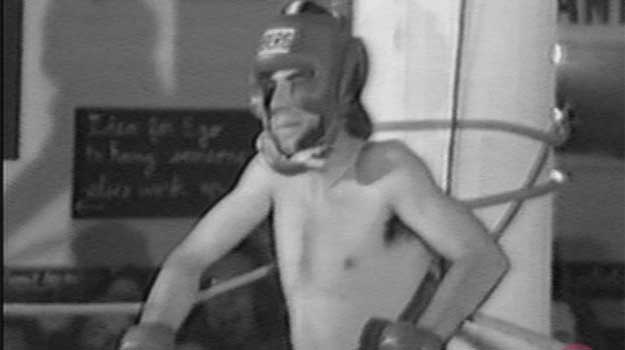
克里斯多夫‧柏拉澤 Christoph Blase 1972, 09:30mins
簡介/Synopsis
1972年10月8號,卡塞爾的第五屆文件大展以一場騷動拉上帷幕:約瑟夫‧波伊斯這位世界知名的藝術家,在當時以51歲的年齡跟比他小30歲的學生亞伯拉罕‧大衛‧克里斯提安進行了一場拳擊比賽。這場拳擊在文件大展的主展場弗利德利西安農博物館的大廳舉行,共進行了3輪,耗時將近10分鐘。
這個行動並不是件獨立的藝術作品。 波依斯希望藉此能讓大家再次注意到他在文件大展上宣傳了100天的 「通過全民公決實現直接民主之組織」。所以這場拳擊賽就變成了一場帶有娛樂性質的政治示威活動。
On 8 October 1972, the documenta 5 in Kassel closed with a spectacular event: Joseph Beuys, the world-famous artist, then 51 years of age, squared off in a boxing match against his student, Abraham David Christian, 30 years his junior. The fight took place in the great hall of the documenta’s main building, the Fridericianum, continued for three rounds and lasted for just 10 minutes.
The action, however, wasn’t declared a work of art in its own right. Beuys much rather wanted to drum up attention once more for his “Organisation for Direct Democracy by Plebiscite”, which he had been promoting for 100 days during the documenta. Consequently, it became a political demonstration with a certain entertainment value.
﹉﹉﹉
ꕥ 作品介紹 2
波依斯的油脂角落 Die Fettecke von Joseph Beuys
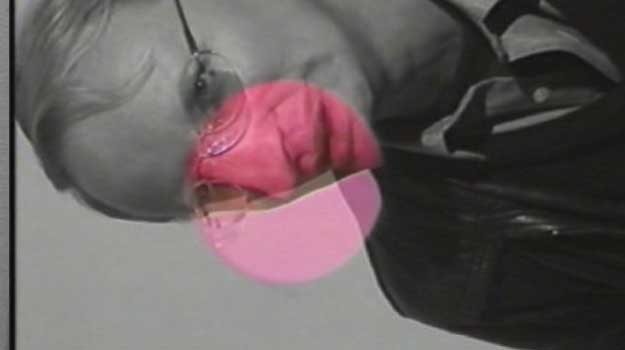
米夏艾爾‧比利契 Bielicky 1986-87, 39:26mins
簡介/Synopsis
眾所周知,一件藝術品會永留青史常常是因為跟某個轟動一時的事件有所關聯或是其肇因。不過如果這項轟動事件日後成了別的作品的樣本,就變得特別有趣了。米夏艾爾‧比利契和李卡多‧培雷多在1987年聯合攝製的作品「油脂角落」就是這樣。他們用紀錄片的方式,報導清除波依斯在杜塞爾多夫藝術學院填起來的著名油脂角落的過程:加上波依斯當年的同志之言論,透過剪接和鏡頭的交疊,如同藝術創作的手法。
藉由藝術本身的手段重新改寫藝術史上的一部作品。
That works of art go down in history because they were associated with a scandal or because they caused one, is well-known. It becomes particularly interesting, however, when the scandal later provides the impetus for a new work. And that is what happened in the 1987 video, Die Fettecke (The Fatty Corner), by Michael Bielicky and Ricardo Peredo. It reports in a documentary style on the removal of the famous “Fettecke”, which Joseph Beuys had installed in the Düsseldorf Academy: Beuys’ contemporaries have a say in an, as it were, artistic treatment produced by editing or by superimpositions.
A piece of art-history writes itself anew using art’s own means.
﹉﹉﹉
ꕥ 作品介紹 3
我們用捲心菜的紅作畫 Wir malen mit dem Rot des Kohls
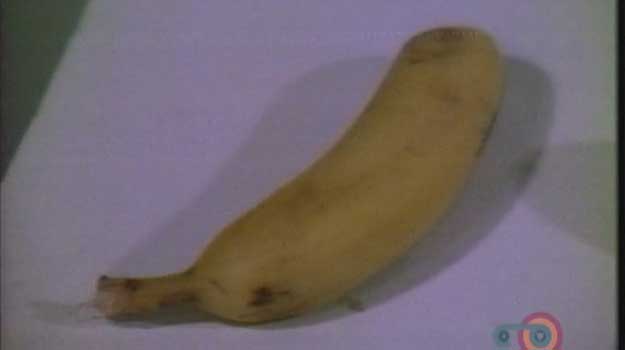
克勞斯‧柏姆爾 Claus Böhmler 1974, 14:04mins
簡介/Synopsis
克勞斯‧柏姆爾1974年所作的「我們用捲心菜的紅作畫」創造了一種視覺詩和互動藝術之混合體。為了反思語言、顏色和材質的議題,柏姆爾利用各式水果和蔬菜作為出發點。影片中不斷出現對於影像媒介的批評,尤其最明顯的是他指示觀眾「請走到您的電視機前,把藍色調好!」 不僅是語言突然可以解釋顏色,而且當時的彩色電視的技術,也能夠讓觀眾自己去詮釋對色彩的想像。
In 1974, Claus Böhmler created a mixture out of a visual poem and an interactive artwork with his Wir malen mit dem Rot des Kohls (We are painting with Red Cabbage Red). Sorts of fruit and vegetables serve the artist as a starting-point for reflecting on the themes of language, colour and material. A critical engagement with the video medium always floats along with that and reaches its high point in instructions, which viewers are to carry out: “Go to your TV set and turn up the blue tone!” It is not only language that is suddenly interpreting colours, but the technology of colour televisions in those days in turn allows viewers to – ostensibly – have their colour images interpreted.
﹉﹉﹉
ꕥ 作品介紹 4
綁架一個畫商不再是烏托邦 Die Entführung eines Kunsthändlers ist keine Utopie mehr
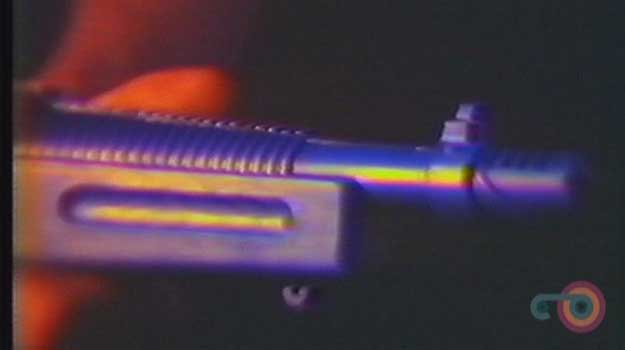
克勞斯‧馮布魯赫 Klaus vom Bruch 1975, 06:46mins
簡介/Synopsis
單是就標題「綁架一個畫商不再是烏托邦」,觀者就知道這部克勞斯‧馮布魯赫1975年所拍的片是一部驚悚片。事實上,著名的電影「粉紅豹」的原聲帶又巧妙地增加了影片的懸疑性。觀眾們自然而然就會聯想到間諜片:一個神秘的陌生人,手持一把槍站在鏡頭前,除了他的武器上刻著「008」之外,我們對他就一無所知了 … 。同時,這件作品以及它的標題也暗示了當時發生的一個事件:在此前不久,1975年紅軍旅綁架了彼得‧羅倫斯。
The title already signals it – with Klaus vom Bruch’s “Die Entführung eines Kunsthändlers ist keine Utopie mehr” (Kidnapping an Art-Dealer is no longer a utopian Proposition) from 1975 viewers are dealing with a thriller. And as a matter of fact, the soundtrack to the well-known film, “The Pink Panther”, plays its part in adeptly increasing the suspense in this video. In this way, viewers feel reminded of a spy film: a mysterious stranger stands before the camera holding a gun, and we know nothing else about him than that “008” is engraved on his weapon… At the same time, the work and its title also play on the current affairs of those days: the kidnapping of Peter Lorenz by the RAF (Red Army Faction) a short time earlier in 1975.
﹉﹉﹉
ꕥ 作品介紹 5
葛瑞琴‧杜曲科 Gretchen Dutschke
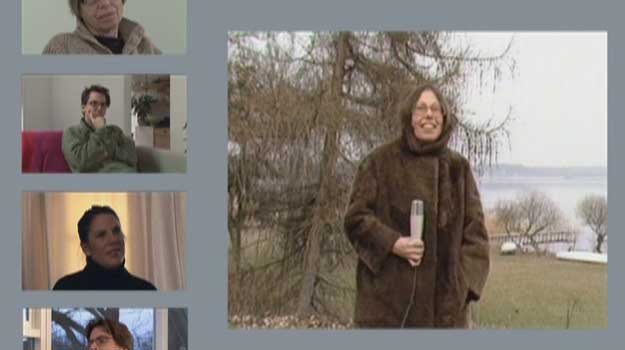
葛特‧孔拉德 Gerd Conradt 1985/2009, 14:36mins
簡介/Synopsis
1985年米夏艾拉‧布榭與葛特‧孔拉德一起拍攝了一部描寫德國二十世紀六十年代學生運動領袖葛瑞琴‧杜曲科‧科羅次之電視影片,不過這部片子最後胎死腹中。葛瑞琴在片中講述了她的童年以及她在歐洲的生活。23年之後,這部舊影片的主要內容又再次被播放給葛瑞琴和她已經長大的三個孩子觀看,他們第一次看到這部訪問片的種種反應則被攝影機記錄下來。
這件裝置由5個基座組成,其上放有螢幕,其中4個螢幕分別呈現三名已成年的孩子以及母親的畫面,另外一個較大的、正對其他螢幕擺放的螢幕則是放映那一場歷史性的採訪。
In 1985 Michaela Buescher and Gerd Conradt filmed a portrait of Gretchen Dutschke-Klotz for a television film, which was never realized. In it, Gretchen talks of her childhood and of her life in Europe. 23 years later the old material, focusing on its most central points, was shown again for the first time to Gretchen herself and to her three children, now adults, while their reactions at their first viewing were filmed.
The installation is made up of five pedestals with monitors, four of which each show the adult children as well as their mother individually, and one larger one facing the other monitors and showing the historical interview.
﹉﹉﹉
ꕥ 作品介紹 6
以「清涼池」回顧整年 Jahresrückblick mit Cool in the Pool
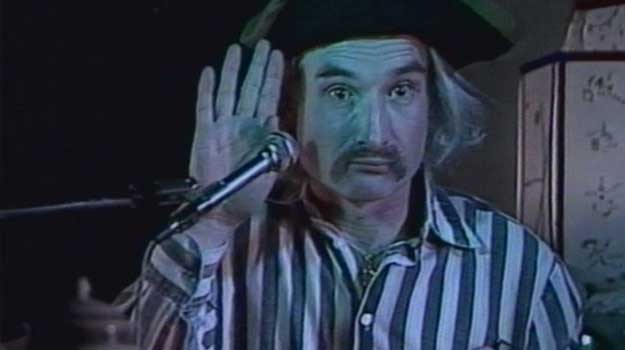
霍佳‧蘇凱 Holger Czukay 1982/1978, 15:47mins
簡介/Synopsis
霍佳‧蘇凱是傳奇的搖滾樂團「罐頭」的組團元老之一,就像一架幽浮從別的星球漂進他的工作室。他就像夢遊一般地使用控音器、電話以及鼓,呼應著他對麥克風喊出與低聲沉吟的語句。表面上這部片子是在回顧1982這一年,不過事實上蘇凱已經對整個20世紀做了總結。不連貫的爆破發音的方式加上諷刺的內容直接的衝擊觀眾。
片中的工作室場景出現在蘇凱最有名的音樂錄影片之一的「清涼池」中。不過這部片子不是1980年眾所週知的那個版本,而是至今尚未發表過的1978年的出版。
Holger Czukay, co-founder of the legendary rock band CAN, comes floating into his studio like a UFO from another planet. Like a sleepwalker he works control units, telephone and drums in order to emphasise the sentences he shouts or breathes into the microphone. Superficially, this is about looking back on the year 1982, but, in fact, Czukay is already settling accounts with the entire 20th century. His cynical messages hit the viewer in staccato sequence.
This studio scene segues into the music video“Cool in the Pool”, one of Czukay’s best-known pieces. However, here we don’t see its famous 1980 version, but its first, hitherto never published version from 1978.
﹉﹉﹉
ꕥ 作品介紹 7
海克力斯 Herakles
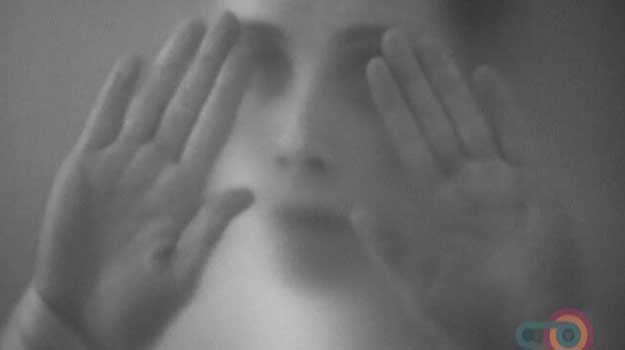
盧次‧丹貝克 Lutz Dammbeck 1984, 10:28mins
簡介/Synopsis
受到海涅‧穆勒的「海克力斯二」或是「九頭蛇」以及格林童話的「倔強的小孩」的啟發,盧次‧丹貝克在1984年的「海克力斯」中批判性地探討了獨裁統治體系:古代的海克力斯身上之善良美德,與令人有邪惡聯想的德國法西斯藝術融成一氣。丹貝克想通過這樣的組合對超人這個完美的想像進行解構,並揭發隱藏其中的法西斯的扭曲併吞。這部批判體制的作品,終究被德國電影股份有限公司一再的拒絕,丹貝克只能以個人製作的方式完成。
In his 1984 “Hercules”, inspired by Heiner Müller’s “Herakles 2 oder Die Hydra ” (Hercules 2 or The Hydra) as well as the Grimm fairytale,“Das eigensinnige Kind” (The wilful Child), Lutz Dammbeck deals critically with the topos of authoritarian systems of dominance: the moral goodness of the Hercules of antiquity is combined with its capture by the art of German fascism, with all its evil connotations. Through this synthesis, Dammbeck wants to deconstruct the ideal image of the “Übermensch” (superman) effectively and demonstrate the implicit fascist annexation. This approach levels a critique on established systems and, in the last analysis, led to the project being rejected by DEFA several times so that it could only be realised as an independent production.
﹉﹉﹉
ꕥ 作品介紹 8
星際戰士–「視覺詩」三部曲的出兵前線的故事
Starfighter – Geschichte eines Fronteinsatzes aus der Trilogie“Visuelle Poesie”
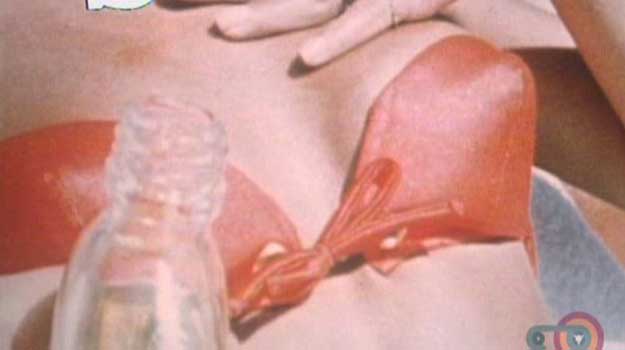
克勞斯‧彼得‧丹科 Klaus Peter Dencker 1970, 06:00mins
簡介/Synopsis
在1970年為巴登-巴登的西南廣播電台所製作的影片「星際戰士」中,克勞斯‧彼得‧丹科將「具體詩」的方法運用到影像媒體上,他用文字遊戲的方式以“Starfighter“這個詞為基礎,創造出許多新詞,並開發出新的聲音效果,然後在視覺上把聯想出來的「字/畫鍊」重新組合。在他的「畫/音拼貼」之中,他使用劇情片與廣告片作為影片素材,配上蒙哥‧傑瑞樂團的歌曲「勇士」和來自英語課本中的語言序列、新聞和自己製作的聲音素材。其中很多特效都是通過當時還很新的藍盒子技術(虛擬演播室系統)完成的。
In “Starfighter”, the video he produced for the Südwestfunk in Baden-Baden in 1970, Klaus Peter Dencker applies the techniques of concrete poetry to the video medium by proceeding from the word, ‘Starfighter’ to create new coinages through word-play and sound effects and combines them into new associative chains of words and images. He uses readymade film material from feature films and advertisements for his collages of images and sound and underpins it with the song, “Mighty Man”, by the group, Mungo Jerry, as well as language-sequences from an English learners’ textbook, from the news and from sounds he produces himself. Many effects were achieved by using the bluebox technology that was still new in those days.
﹉﹉﹉
ꕥ 作品介紹 9
東尼 Toni
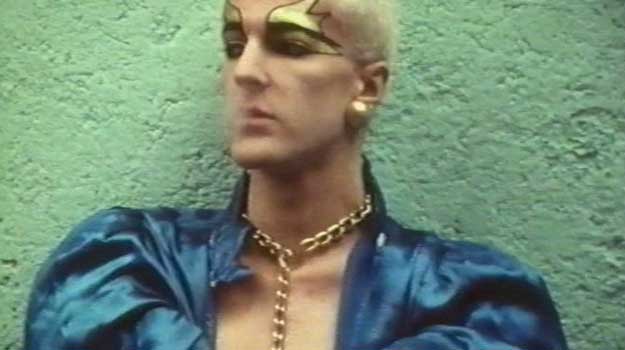
沃夫岡‧弗拉茲 Wolfgang Flatz 1981, 00:11mins
簡介/Synopsis
雖然弗拉茲這部拍攝於1981年的影片「東尼」非常的短、僅有10秒鐘,不過卻非常吸引人,只是它無窮無盡的循環方式很快就讓觀眾厭煩。影片中,東尼是一位慕尼黑著名的設計師,同時也是一個康特剛藥物的受害者。當觀眾看到他站在一堵牆前享受地吸著煙,就會很快明白,東尼並不認為自己是一個受害者,相反地,他是一個在享樂中揮霍生命的人。影片的背景配上萬寶路香菸挑釁的廣告語,當時香煙的廣告已經不准在電視中出現。
Although Flatz came up with a very short work of only just 10 seconds with their 1981 video, “Toni”, the work is fascinating and rapidly gets on viewers’ nerves with its continual loop-repetitions. What it shows is Toni, a fashion designer well-known in the Munich scene and a casualty of Thalidomide to boot. Viewers see him standing up against a wall enjoying a smoke and so quickly get the idea that he does not understand himself as a victim, but, on the contrary, as a person relishing his life hedonistically. Accompanying that is an advertising slogan for the Marlboro cigarette brand – and this at a time when cigarette advertising was already forbidden on television.
﹉﹉﹉
ꕥ 作品介紹 10
存在的虛構 II:無敵者 Seins Fiction II: Der Unbesiegbare
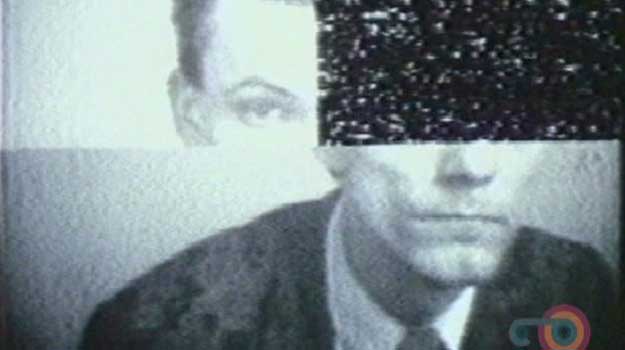
古斯塔夫‧哈莫斯 Gusztáv Hámos 1983/87, 25:20mins
簡介/Synopsis
在古斯塔夫‧哈莫斯1983/1987年的作品「存在的虛構 II:無敵者」之中,觀眾將與亞歷山大‧雷蒙得所創造出來的超級英雄人物弗拉旭‧格爾登共同經歷一場冒險。同時,藝術家還很成功地探討了錄影短片與電影間的關係,以及觀者觀看它們之時不同的認知方式。他應用不同的戲劇佈局的效果 —— 時而使用客觀的特寫鏡頭,時而使用主觀的運鏡 —— 目的便是讓這兩種方式清楚地呈現,整部作品用處理聲音和畫面的情節的手法,還製造了緊張的效果,令人印象深刻。
In the work, “Seins Fiction II: Der Unbesiegbare” (Signs Fiction II: the Invincible) from 1983/1987, viewers are caught up in an exciting adventure, which they experience together with Flash Gordon, the famous super-hero created by Alex Raymond. At the same time, the artist successfully investigates the relationship between video and film and the differing reception of the two forms. The different mis-en-scène – now through objective close–ups, now through subjective camera movement – is meant to make this dichotomy visible and, beyond that, to evoke the tensions, which the whole work impressively radiates by means of its acoustic and visual storyline.
﹉﹉﹉
ꕥ 作品介紹 11
剷平美術館 Das Haus der Kunst abtragen
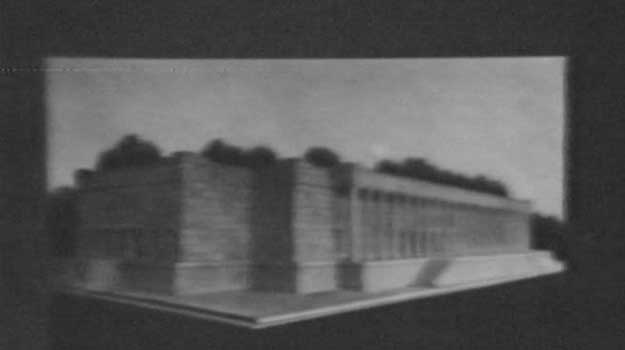
魯道夫‧賀次 Dr. Rudolf Herz 1980, 36:39mins
簡介/Synopsis
在製作1980年的錄影短片「剷平美術館」時,魯道夫‧賀次與羅絲‧托馬直接以輝煌的藝術殿堂為目標:他們想毀掉慕尼黑美術館 —— 這是一座因納粹背景而背負歷史象徵的建築,今天則是世界最著名的展覽館之一。他們很謹慎地展開行動,設法弄到建築平面圖,徵求爆破專家的意見,或者研究美術館員工的行為習慣。另外,他們的作品還探討了錄影片這種媒介操控現實的能力:錄影片看似客觀的紀錄方式,帶出的卻是一個歷史書寫的虛構部分。
With their 1980 video, “Das Haus der Kunst abtragen” (Removing the Haus der Kunst/House of Art), Rudolf Herz and Ruth Toma take direct aim at the hallowed halls of art: they want the Haus der Kunst in Munich – an edifice with heavy symbolic import from its Nazi past and today belonging the world’s most renowned museums – destroyed. In the process, they work very fastidiously, get hold of site-plans, ask ostensible demolition experts or study the routines of the museum staff. Beyond that their work deals with the capacity of the video medium to manipulate reality: the video’s ostensibly objective documentary quality brings a fictive element in historiography to the fore.
﹉﹉﹉
ꕥ 作品介紹 12
給藝術家 Für Künstler
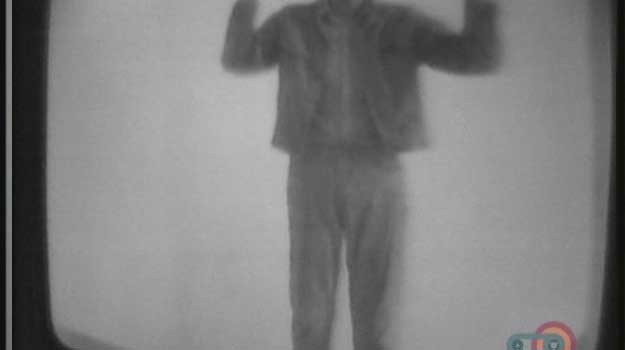
約亨‧西曼 Jochen Hiltmann 1972, 13:31mins
簡介/Synopsis
約亨‧西曼1972年的作品「給藝術家」可以看作是一部片中片的錄影短片,探討的主題是藝術家的角色,以及他們與媒體系統的關係。作品營造出較為壓抑甚至幽閉恐怖的氣氛:由於是用特寫的鏡頭拍攝,一開始螢幕看起來就像是個很小的監獄,而藝術家就被關在裡面。唯一的出路只能是:竭力解放自己! 然後銜接此絕境景象的顛覆性的一幕就發生了,電視螢幕被砸個粉碎,這是對媒體最嚴厲的批判行動,不留任何情面地抨擊了電視以及整個媒體體系。
Jochen Hiltmann’s 1972 work,“Für Künstler”(For Artists), can be interpreted as a video-in-a-video, which deals with the role of artists, or respectively, their relationship to the media system. With that, the work radiates something depressing, even claustrophobic: being shot in close-up accordingly makes the monitor begin to seem like an excessively small prison-cell, where artists are locked up. There can only be one way out, namely: throw everything you have into freeing yourself! This aporia thereupon climaxes in the subversive act of smashing the screen – an action speaking profoundly critical of the media, as the television and with it the entire media system really is radically attacked.
﹉﹉﹉
ꕥ 作品介紹 13
光中的運動 Movements in Light
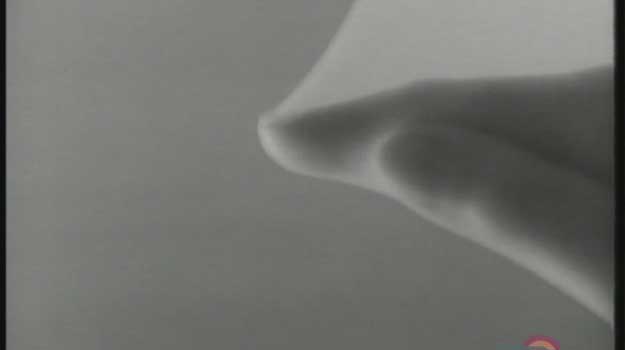
南‧胡弗基金會
Nan Hoover Foundation
1975-1976, 16:36mins
簡介/Synopsis
1975年的「光中的運動」是南‧胡弗的早期作品之一,也正代表她放棄繪畫改從事錄像藝術的轉變。她利用光線與陰影的效果,以及聽起來有威脅感、陰沉的雜音背景處理後,我們本來以為很熟悉的人體部分,像是臉、手背或手指被揭露成總總的錯覺形象,幾近看不出它們本來的形狀,而變成獨立的影像,最終成為令人毛骨悚然的風景。
就在今天這個影像氾濫的時代,胡弗的錄影短片要求我們以一種我們不熟悉的理解方式去看待事物:放慢觀看,目光緩慢地漫遊在畫面之上。
“Movements in Light”from 1975 is one of Nan Hoover’s early works and marks her shift from painting to video. By means of light and shadow effects, as well as a threateningly sombre-sounding soundtrack, the illusion of the human body as a supposedly well-known and familiar terrain is revealed once more. In this process, individual parts of the body, like the face, the back of a hand or a finger appear almost disembodied and, in the last analysis, emancipate themselves to become eerie landscapes.
Precisely in this contemporary age flooded with images, Hoover’s video demands to be received in a manner apparently strange to us: the downtempo gaze, where eyes wander slowly across the screen.
﹉﹉﹉
ꕥ 作品介紹 14
注意,開拍 Achtung Aufnahme
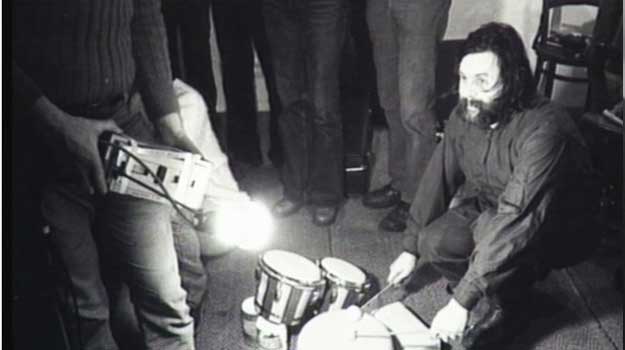
沃爾夫‧卡稜 Wolf Kahlen
1980/2001, 22:52mins
簡介/Synopsis
所有到場嘉賓的神經都高度緊張,每個人都屏住呼吸 …然後,突然一聲大叫「注意,開拍」。1980年2月1號沃爾夫‧卡稜在東柏林的一家畫廊所作的同名表演錄影,其中多次大聲喊出這兩個詞,應該就是像這般的情景。接著的一幕是,卡稜將鏡頭固定於一點,凝結當下的情景和影像畫面,然後拉弗‧溫科勒,其藝名是AR‧彭克,便馬上使用這些畫面進行即時現場創作。
這部短片因此不僅是一部表演藝術的紀錄,而且幾乎其本身就是一部創作作品夾。
The nerves of all the guests present are on edge, and everyone is holding their breath …then the call suddenly comes: “Heads up, shooting”. That, or something like it, is how it must have been, when Wolf Kahlen called out these words several times during the eponymous video performance on 1 February 1980 in an East Berlin gallery. And to follow: Kahlen’s locking of the camera onto one point and the freezing of this situation and the associated video image, which Ralf Winkler, alias A.R. Penck, will immediately use for the ad hoc overpaintings he realised there and then.
The video is, therefore, not only a documentation of the events, but simultaneously an adeptly matched portfolio, as it were.
﹉﹉﹉
ꕥ 作品介紹 15
舊電視機收集處 Sammelstelle für Alt-Fernsehgeräte
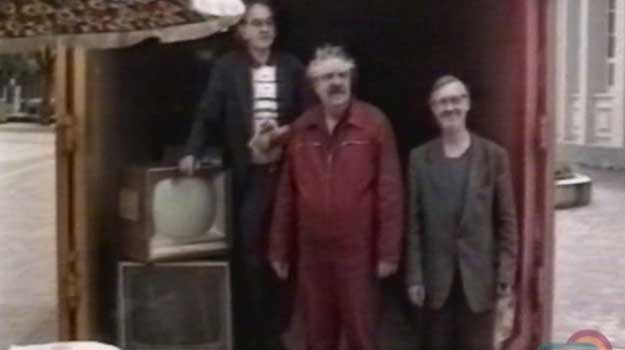
安德烈‧寇皮斯與馬庫斯‧勒弗樂 Korpys/Löffler1995, 07:52mins
簡介/Synopsis
安德烈‧寇皮斯與馬庫斯‧勒弗樂1995年所作的「電視機收集處」是一件對媒體批判的幽默行為藝術作品,亦為同名的錄影短片提供了素材。這場行為藝術是屬於卡爾斯魯厄「第四屆多媒體展」的活動項目,但是同時又是反對這個機構的作品。它諷刺媒體藝術致力博物館化的現象。這件行為藝術作品是與其他藝術家友人共同創作的,被當作是公共空間中的互動雕刻,跟當時大家對媒體藝術的想像以及多媒體展中所展出的作品大相逕庭。
在此放映的錄影短片是紀錄整個行動藝術過程的附帶產品。
The 1995 action,“Sammelstelle für Alt-Fernsehgeräte”(Collection Point for old Television Sets) by Andree Korpys and Markus Löffler is humorously critical of media-art and provides the material for this eponymous video. It was planned in the context of the MultiMediale 4 in Karlsruhe and at the same time as a counter-event to that, ironising the diligent incorporation of media-art into museums. With a wider group of artist-friends, the action was consciously set up as an interactive sculpture in public space and with that contradicts the notion of media-art current in those days and the corresponding works presented at the MultiMediale 4.
The video shown here came about as an ancillary product and documents the entire action.
﹉﹉﹉
ꕥ 作品介紹 16
卡西柏 Cassiber
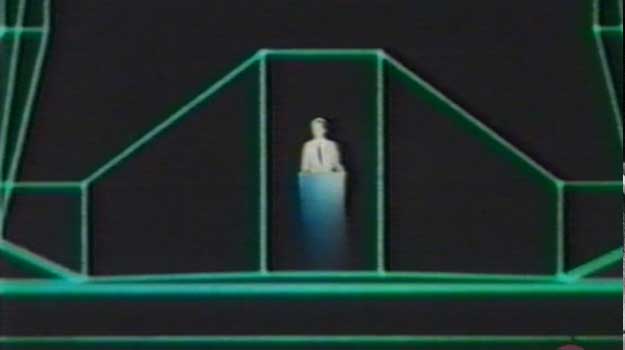
賈特‧郭斯科 Gerd Kroske
1988/1989, 28:50mins
簡介/Synopsis
1988/1989年的錄影短片「卡西柏」是東德藝術家賈特‧郭斯科、烏利希‧維斯特、馬利歐‧沛徐、烏威‧包佳尼和佑根‧庫特尼與德英兩國的搖滾樂團卡西柏聰敏合作的結果。受到柏林藝術大學的藝術家之錄製新專輯的邀請,卡西柏來到了東柏林。獨一無二的音樂錄影拼貼就此產生 —— 既是對音樂製作過程的紀錄,本身又是真正的藝術作品。就這點而言,這部錄影就像一個真正實現出來的烏托邦,可能只有在德意志民主共合國矛盾的社會主義的最後一個階段,才得以造就出來這般情境。
The 1988/1989 work, is the result of the East German artists Gerd Kroske, Ulrich Wüst, Mario Persch, Uwe Baumgartner and Jürgen Kuttner working cleverly together with the Federal German/British rock group, Cassiber. Cassiber travelled to East Berlin following an invitation from the artists at the Academy of the Arts to record their new album there. In the process, a unique music video collage transpired – at once a documentation of how music comes about and also a genuine artwork. In this respect, the video comes across as a piece of a utopia made real, something that could only have been put through in the last phase of the paradoxical socialism in the GDR (German Democratic Republic).
﹉﹉﹉
ꕥ 作品介紹 17
拍影片-拍影片的人-4分鐘環遊世界 filmen – filmer – In 4 Minuten um die Welt
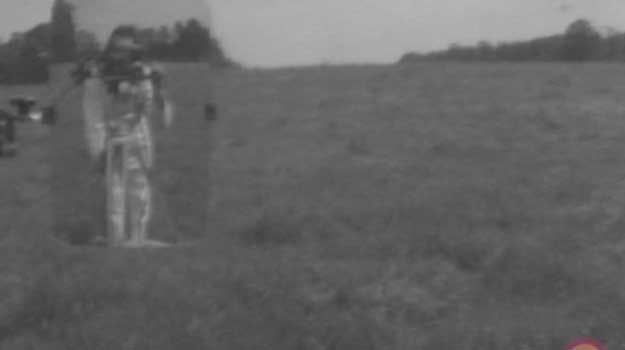
艾德蒙‧庫波 Edmund Kuppel 1975, 05:08mins
簡介/Synopsis
艾德蒙‧庫波1975年的錄影作品「拍影片-拍影片的人-4分鐘環遊世界」用偽實驗的方法在短短幾分鐘內環遊地球。做測試的人即是藝術家本人,他全身上下的連身服給人科學家的感覺。只見他腳步輕快地穿過一片草地,向地平線走去,直到他消失在視野之外。片刻之後,攝影機從後面又漸漸地接近他。 這個死角本來是無法用攝影機拍到的,但利用鏡子的一套設備之輔助下,就可達成。 於是完成了一場完美無缺環遊世界虛構之旅。
Edmund Kuppel’s 1975 video,“filmen – filmer – In 4 Minuten um die Welt”(filming –filmer / filmmakers – around the world in four minutes) shows a pseudo experiment in the attempt to circle the globe in four minutes. The subject of the test is the artist himself, who, in his full-body suit, comes across as a scientist. He walks across a pasture towards the horizon at a brisk pace until he disappears from view. A few moments pass, and we see him then coming up to the camera from behind. This blind spot, in actual fact out of camera shot, is reached by a special apparatus using a mirror. The illusion of a successful trip around the world is perfect.
﹉﹉﹉
ꕥ 作品介紹 18
無題 ohne Titel
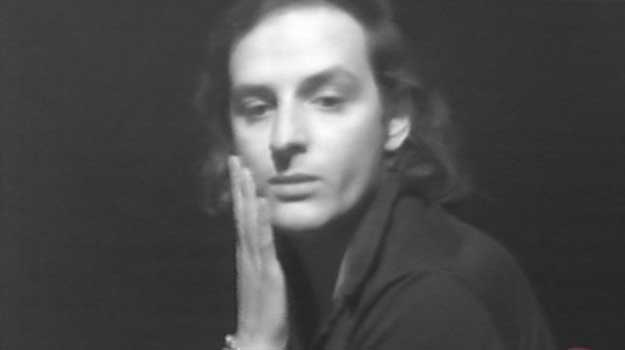
烏爾斯‧盧提 Urs Lüthi 1973, 03:05mins
簡介/Synopsis
當時正值26歲的烏爾斯‧盧提坐在攝影機前,開始如作夢般的看到廣闊的想像世界。正當荷西‧費理其阿諾的歌曲響起的那一刻,一隻手突然從畫面下方出現,保養良好的纖纖玉手和手鐲,讓觀者猜這應該是個女人的手。她的手輕柔地撫摸藝術家,從肩膀到下巴、脖子、臉頰、額頭到頭髮,並溫柔地探觸這個眼前的物體。
在這部攝於1973年的錄影中,盧提消除了性別界限:眼睛所渴望的對像不再是女性,而是男性。重新界定藝術史傳統中的女人(被動)與男人(主動)的關係。
Urs Lüthi, then a 26-year-old, is sitting in front of the camera and gazing dreamily into imagined worlds. At the precise moment a José Feliciano song begins, a hand suddenly rises up from the lower edge of the frame; the manicured, slender fingers and a wrist-watch suggest that of a woman. Her hand gently runs across the artist’s shoulder up to his chin, his neck, cheek, forehead and hair and tenderly explores the object offered to her.
In his 1973 video, Lüthi removes the boundaries between the genders: the desired object of the gaze is not female any more, but male – with that, art history’s traditional relationship between woman (object) versus man (subject) is negotiated anew.
﹉﹉﹉
ꕥ 作品介紹 19
關於威廉‧萊西 ─ 小人物萬歲 Über Wilhelm Reich – Viva Kleiner Mann
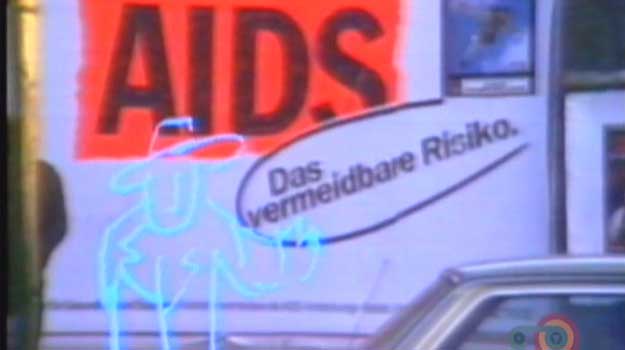
笛妮‧梅樂‧馬克薇茲 Digne Meller Marcovicz 1987, 90:00mins
簡介/Synopsis
在這部1985年的「關於威廉‧萊西 ─ 小人物萬歲」的影片中,笛妮‧梅樂‧馬克薇茲將關於萊西的總總參考資料編成環環相扣的網絡,而使他的一生能夠重建起來,而讓一部獨一無二的傳記成為可能 —— 同時演繹出他多舛的命運與傑出的學術成就。藝術家在片中沿著這名在他的時代很重要的心理學家之足跡探尋,並向許多跟他同甘共苦的同儕人物詢問,其中包括他的事業夥伴和對手、親戚、朋友以及與他多年合作的律師。所有這一切都發生於威廉‧萊西去世將近30年之後,在探索他的可能消失之前,這部片子拍得正是時候。
In her “Über Wilhelm Reich – Viva Kleiner Mann”(On Wilhelm Reich – Viva, little Man) from 1985, Digne Meller Marcovicz weaves a web of references and in that way makes reconstructing of a unique biography possible – an eventful personal destiny and a distinguished scholarly career. In the process, the artist follows in the footsteps of one of the most significant psychologists of his times and asks numerous protagonists involved in his life and his failure: collaborators and opponents, relations, friends or also his long-time lawyer. This all happens almost 30 years after Wilhelm Reich’s death and in that comes in the nick of time just before the natural time-window making this possible might have closed for ever.
﹉﹉﹉
ꕥ 作品介紹 20
資本論 Das Kapital
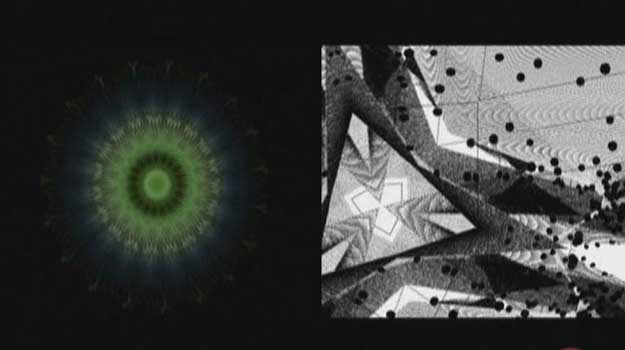
馬賽羅‧梅卡多 Marcello Mercado 1999-2008, 60:00mins
簡介/Synopsis
阿根廷導演馬賽羅‧梅卡多1999年來歐洲之時,同時帶了幾千張照片與影片。這些資料是從阿根廷警察局的垃圾桶蒐集來的,是暴力犯罪受害者的照片。就技術的角度來看是傳統的材料,它們被最現代的電腦軟體處理後,組成無止境的影像拼貼圖。一件媒體藝術作品因此而產生,每年還繼續的成長,還在不斷地變化。就像卡爾‧馬克思從未寫完他的「資本論」,梅卡多不斷改變這件由數位技術製造出的影音「資本論」─ 直到今天。
這件作品沒有最終的版本,而只有片段。就像「資本論」不斷的流逝,可是我們還是可以感受到它的存在。
When the Argentinean Marcello Mercado came to Europe in 1999, he brought with him thousands of photos and films. They came from the rubbish bins of Argentinean police stations and depict victims of violent crime. This – from a technological point of view – conventional material was combined using the most advanced computer software to form collages overflowing with images. A work of media art was created, which is still evolving, growing with every year. Like Karl Marx, who never finished “Das Kapital”, Mercado modifies his digitally produced, audiovisual Kapital again and again – right up to today.
There is no final cut, just an extract. Kapital volatilizes time and again, but nevertheless its presence can be felt.
﹉﹉﹉
ꕥ 作品介紹 21
娃雷斯卡‧基爾特:新生兒、死亡 Valeska Gert: Das Baby, der Tod
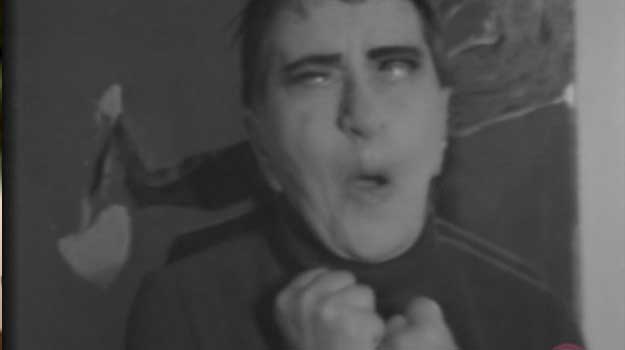
恩斯特‧米茲卡 Ernst Mitzka 1969, 05:59mins
簡介/Synopsis
從1920年代開始娃雷斯卡‧基爾特就是一位知名,且非傳統的舞者與演員。在當時她的演出已經具有60年代表演藝術之特質。1969年當錄像機還是完全非常新的產品的時候,恩斯特‧米茲卡成功地說服了娃雷斯卡‧基爾特,在錄影機前表演兩場作品。娃雷斯卡‧基爾特直接看著錄影機,在短短的幾分鐘之內,她生動的臉部表情道出了人生的開始與結束:新生兒、死亡。
這部錄像作品之前從未放映過。直到今天,拍攝完成40年之後,才又被發現並修復。
From the 1920s onwards, Valeska Gert (1892–1978) was a famous, albeit unconventional, dancer and actress. Her appearances on stage anticipated crucial qualities of the performance art of the 1960s. In 1969 – at a time when video recordings still were a real novelty– the artist Ernst Mitzka was able to talk her into performing two pieces in front of the video camera. Valeska Gert faces the camera and in the space of only a few minutes her mimic reflects the beginning and the end of life: Das Baby, der Tod – The Baby, Death.
However, the videos were never shown. Only now, almost 40 years after recording, they re-emerged and were restored.
﹉﹉﹉
ꕥ 作品介紹 22
M.穿越加崙廷附近的湖 M. überschreitet den See bei Gallenthin
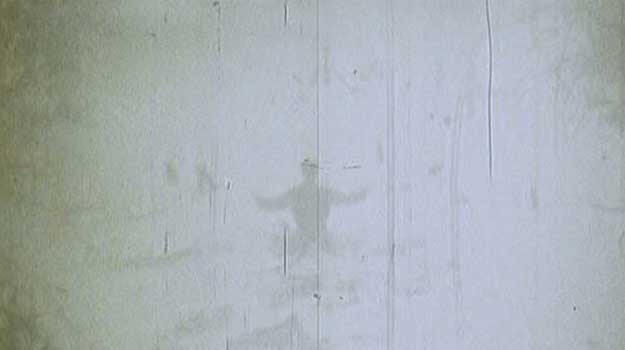
米夏艾爾‧莫格內 Morgner
簡介/Synopsis
在觀看「M. 穿越加崙廷附近的湖」這部影片之時,觀眾變成了一場充滿政治火藥味的顛覆性行動之見證人:這是德意志民主共和國最早的的表演錄影之一,米夏艾爾‧莫格內於1981年9月27日施威林的附近,在諸多嘉賓在場的情況下,如克勞斯‧史塔克,是用一台偷帶進來的錄影機拍攝而成的影片。影片中,莫格內走進一個養鴨的水塘,直到只有他的頭和向上伸的胳膊露在水面上為止。這個畫面看起來就好像他將如一位彌賽亞,預言某種新事物的到來;而此時徳意志民主共和國的共產主義體制仍是處於興盛期。
The film, “M. überschreitet den See bei Gallenthin” (M. crosses the Lake at Gallenthin) has viewers witness an action, the subversive implication of which connotes political dynamite: we can see one of the first film performances in the GDR (former East Germany), which was shot on 27 September 1981 by Michael Morgner in the presence of various guests – Klaus Staeck, for example – with a smuggled video camera. In it, Morgner wades into a duck pond until only his head or his arm held aloft can be seen. It seems that he wants to make a messianic prophecy on the arrival of something new; and this actually at a point when the GDR’s communist system was still in full flower.
﹉﹉﹉
ꕥ 作品介紹 23
心醉神迷I Ekstase 1
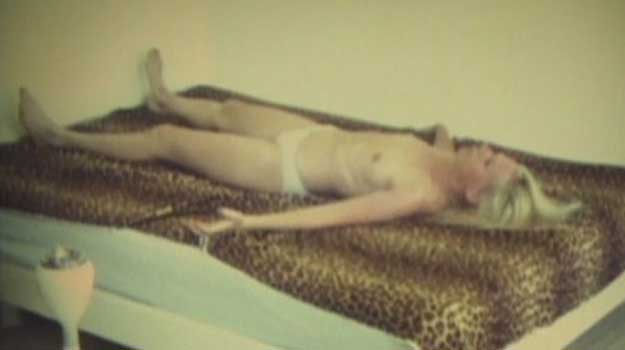
海可‧姆特 Heike Mutter 1998, 06:40mins
簡介/Synopsis
海可‧姆特1998年拍的「心醉神迷I 」是在探索人體在親密興奮時的特別狀態。一個只穿內褲的女人像是被扔到一張鋪了豹皮的塑料床上。她一動不動地躺在那裡,直到她的手指突然開始抽動。抽動越來越劇烈,然後傳導到全身都有反應。當興奮程度達到頂點的時候,這個被折磨的身軀漸漸恢復平靜,再次保持安靜的狀態。
這部錄影片以無盡循環的方式,批判約束身體的紀律,進而批判了受媒體影響極大的權力討論。
Heike Mutter’s “Ekstase (Ecstasy) 1”from 1998 is about exploring the human body at a peculiar moment of intimate tension. A woman clad only in briefs appears to have been thrown onto a synthetic bed covered with leopard skin. She lies motionless until her fingers suddenly start to twitch. The twitching increases taking over her entire body. When her ecstasy has reached its climax, the tormented body settles down again, remaining still once more.
In an infinite loop the video engages critically with the way our bodies are disciplined and with that the discourses of power inscribed by the media.
﹉﹉﹉
ꕥ 作品介紹 24
妮可 Nico
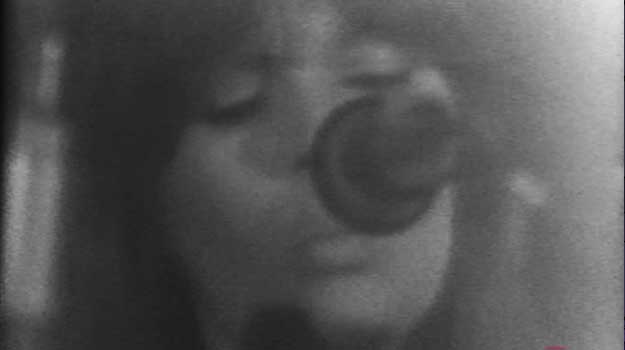
米夏艾爾‧蓋斯勒 Michael Geissler 1974, 17:48mins
簡介/Synopsis
妮可(1938-1988)這位與眾不同的女歌手,跟「地下絲絨」樂團合作才首度為人所知,此次放映的是兩部關於她非常罕見的片子。第一部是錄影藝術的先鋒人物米夏艾爾‧蓋斯勒1974年在她的柏林演唱會中拍攝的。影像有著令人印象深刻的幽暗,同時又具有妮可嗓音一樣的優美。
Nico (1938–1988), the unusual singer who first became known with the band, The Velvet Underground, is shown here in two rare recordings. The video pioneer, Michael Geissler, recorded the first one in October 1974 during her concert in Berlin. The images are as impressively dark and simultaneously as beautiful as Nico’s voice.
﹉﹉﹉
ꕥ 作品介紹 25
妮可像 Nico Icon
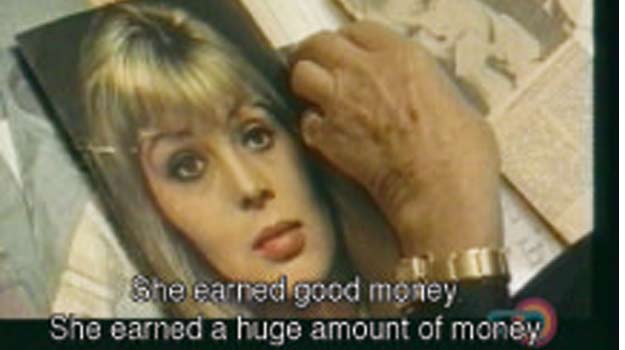
蘇珊妮‧歐芙特琳恩 Susanne Ofteringer 1993, 25:49mins
簡介/Synopsis
第二部影片中我們可以看到獨立電影人蘇珊娜‧歐芙特琳恩1993年用她的Hi 8錄影機描寫妮可。影片本來只是以幾場採訪作切入,很快就延展變成一個深刻的人物描寫。這部錄影篇章最終成了歐芙特琳恩1995年拍攝的一部紀錄片的基礎,而這部紀錄片也在1997年獲得阿道夫-格里姆獎。
The second tape sees the filmmaker Susanne Ofteringer tracking Nico with her Hi 8 camera in 1993. What began with only a few interviews is soon extended to become a comprehensive portrait. In the end, the video essay shown here became the basis for a documentary film shot by Ofteringer in 1995, for which she received the Adolf-Grimme-Award in 1997.
﹉﹉﹉
ꕥ 作品介紹 26
東西方的對話 Gespräche zwischen Ost und West
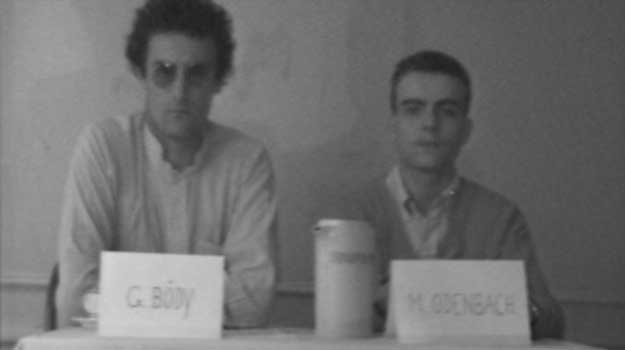
馬賽‧奧登巴哈 Marcel Odenbach 1978, 03:20mins
簡介/Synopsis
馬賽‧奧登巴哈和佳寶‧包笛在他們1978年的錄影片「東西兩方的對話中,批判性地將冷戰時期信誓旦旦的東西對話歸結為:敵對的雙方本來就是除了空洞的言語外,即純粹形式化的廢話外,就沒什麼可以交流的。因為交流的理由,這位德國人和這位匈牙利人只見了一次面——而且還是在他們之間的一位共同友人的巴黎住處會面。他們利用了一些標準的呈現方式,反映當時電視中常見的嚴肅性的政治報導,同時通過極簡主義,成功地表達出他們的媒體批判觀點以及政治態度。
In their 1978 video, “Gespräche zwischen Ost und West”(Conversations between East and West), Marcel Odenbach and Gábor Bódy focus critically on the East-West dialogue much en vogue at the time of the Cold War: the hostile states do not exchange anything other than soap bubbles, a purely formalistic blah-blah. For their purposes, the German and the Hungarian only actually ever met once – and, in fact, in the Paris flat of a mutual friend. With their parameters in their representation, their work additionally reflects serious political reporting, as was usual in TV at the time, and it simultaneously presents a successful media-critical and political statement through its minimalism.
﹉﹉﹉
ꕥ 作品介紹 27
先是一件襯衫,然後是一件藝術品 Erst das Hemd, dann die Kunst
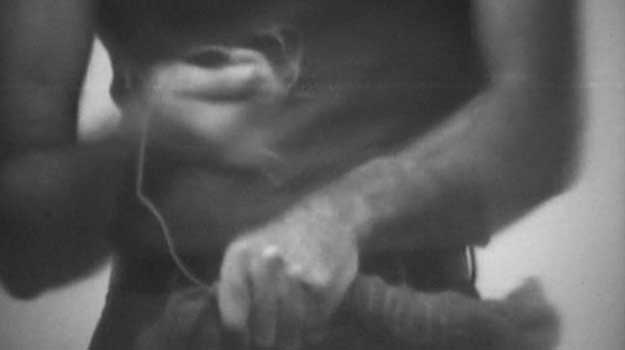
C.O.‧沛弗根 C.O. Paeffgen 1975, 10:16mins
簡介/Synopsis
「先是一件襯衫,然後是一件藝術品」,這是屬於C.O.沛弗根1975年的一組名為「包裝」創作集裏的作品,藝術家因這些作品而出了名。在這部錄影片之中,一件之前脫下來的運動衫被當作素材,然後用金屬線纏繞起來,一件雕塑作品於是形成。隨後被安裝在一面牆上。這個變形的過程,觀者可以從頭到尾一起經歷 —— 把一件這麼普通的東西升等變成藝術作品。不過最後這個生產的過程又被撤銷了:這件運動衫雕塑被從牆上取下來,除去纏繞物,然後被重新穿在了身上。
沛弗根他的作品中將杜象式的現成物之理念做了同質性的擴展。
“The Shirt first, Art second”from 1975 is part of C.O. Paeffgen’s “Umwicklungen” (wrappings) – a group of works which first brought the artist to the attention of the public. A t-shirt, which the artist himself had previously taken off, makes the raw material for this video. With wire wrapped all around it, it becomes a sculpture which is then mounted on a wall. The viewer can witness this metamorphosis – the upgrading of a mundane object to a work of art – in real time. In the end, however, the production process is reversed: The t-shirt sculpture is taken down from the wall, the object unwrapped and put on again.
Duchamp’s concept of the readymade is congenially extended in Paeffgen’s work.
﹉﹉﹉
ꕥ 作品介紹 28
吸氣 Inhalation
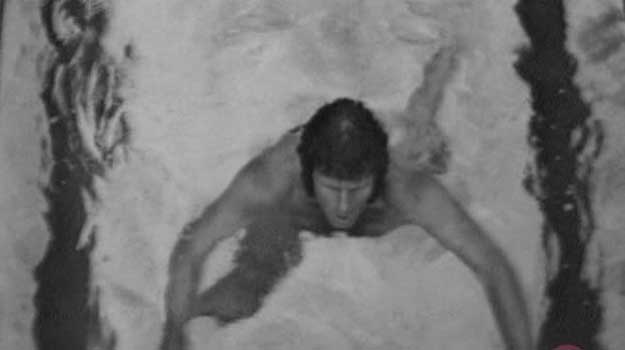
克勞斯‧林克 Klaus Rinke 1971, 03:43mins
簡介/Synopsis
水和身體是克勞斯.林克70年代作品中的核心元素。1971年他與蓋瑞‧蘇姆共同在游泳池裡製作了一部錄影片。我們從上方看到林克一再地探出頭到水面上來呼吸空氣,接著沉入水中,摒住呼吸,到最後一秒再次浮出水面。來來回回18次之多,每次潛入水中的時間越來越短,游泳者也越來越疲憊,最後他離開了水道。這是影片中的第一部份「吸氣」的結局。
第二部分則顛倒過來。我們看到林克頭部的側影,他抓起一個水杯,一口氣喝了1公升水。於是,水這種危險的元素又成為了維持生存不可或缺的東西。
In the 1970’s, water and bodies are the central elements in Klaus Rinke’s work. He, therefore, stays in that vein to also produce a video tape in a swimming bath together with Gerry Schum in 1971. We see Rinke from above as he repeatedly takes deep breaths, dives down into the water, holds his breath and surfaces at the last moment. This is repeated 18 times as the dives become shorter and shorter and the artist more and more exhausted until he swims out of the lane. That closes the first part of“Inhalation”.
The second part shows a reversal. We see Rinke’s head in profile; he takes up a glass of water and drinks a litre at one go. The dangerous element has become one vital to life.
﹉﹉﹉
ꕥ 作品介紹 29
「祝妳好運,做出更好的藝術!」 Good luck for a better art
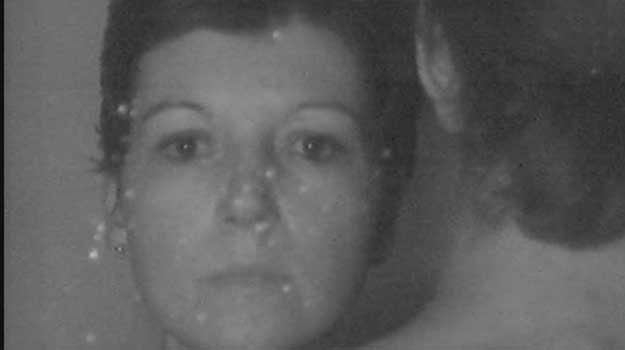
巫莉克‧羅森巴哈 Prof.Ulrike Rosenbach 1977, 05:12mins
簡介/Synopsis巫莉克‧羅森巴哈越過與克勞斯‧馮布魯赫的肩膀,對著一片玻璃板吐牛奶。每吐一次之後,克勞斯‧馮布魯赫都會低聲耳語道:「祝妳好運,做出更好的藝術!」整個片子有點單調,除了玻璃板上的牛奶越來越多之外,其他什麼都沒發生。
這部錄影片拍出來的時候是1977年,正是錄影藝術和行為藝術的第一個十年接近尾聲的時候。許許多多對身體經驗以及媒體批判的探討好像都已經作完了。所以「祝妳好運,做出更好的藝術!」這句話在最後一次牛奶吐出之後,又響亮地齊聲呼喊而出,這可是非常嚴肅的呼籲:拜託作出更好的藝術吧!
Ulrike Rosenbach spits milk over Klaus vom Bruch’s shoulder and against a pane of glass. And every time she spits, Klaus vom Bruch whispers: “Good luck for a better art!” The piece possesses a certain monotony. Very little happens, apart from the pane of glass becoming milkier every time she spits.
In 1977, when this video was produced, video and performance art too were reaching the end of their first decade. Many bodily experiences and media-critical investigations seemed already to have been made. So the message in “Good Luck for a better Art”, which is sung loudly in chorus one last time after she has finished spitting, is meant quite seriously.
﹉﹉﹉
ꕥ 作品介紹 30
一分割、二圓圈、三對角線 1. Teilungen, 2. Kreise, 3. Diagonalen
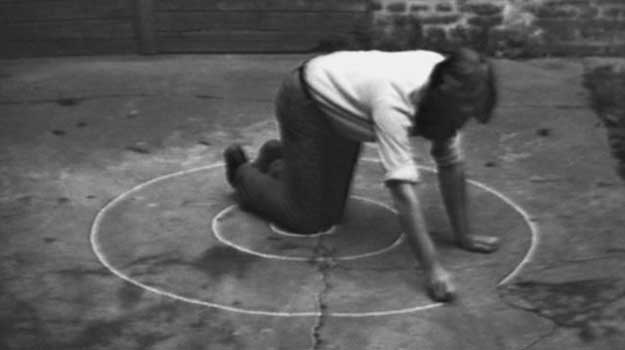
烏利希‧呂科林 Ulrich Rückriem 1971, 20:40mins
簡介/Synopsis
一分割、二圓圈、三對角線這三部錄影片是1970/1971年間烏利希‧呂科林與蓋瑞‧蘇姆和巫素拉‧薇菲絲共同製作的。簡潔的題目已經暗示了作品中所遵循的放棄美學:他們刻意避免掉耗費繁複的圖像製作方式。相反的,藝術家專注於簡單的處理過程,其背景的選擇以及他如何借助自己的身體畫圓圈和斜線,如何分割木板都是刻意將它們簡化地表演出來。呂科林宣稱其目的是藉此有意識地把重點轉移到製作過程的本身。
The videos,“1. Teilungen, 2. Kreise, 3. Diagonalen” (1. Divisions, 2. Circles, 3. Diagonals), were produced by Ulrich Rückriem in 1970/1971 in cooperation with Gerry Schum and Ursula Wevers. The laconic titles already point to the aesthetic of renunciation realised in them: elaborate possibilities for image creation are consciously avoided. On the contrary – the choice of the backgrounds, before which the artist focuses on displaying through simple actions how he can draw circles and diagonals and break wooden laths with the help of his body, is angled at a deliberate simplicity in mounting images. Rückriem’s declared goal is to direct attention consciously onto the production process in that way.
﹉﹉﹉
ꕥ 作品介紹 31
擋住錄影畫面一部分的物體 Objekt zur teilweisen Verdeckung einer Videoszene
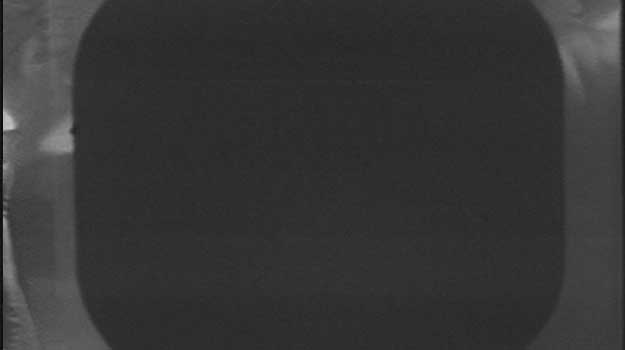
萊納‧盧騰貝克 Reiner Ruthenbeck 1974, 31:45mins
簡介/Synopsis
雖然科隆的新市場,就像萊納‧盧騰貝克在「擋住錄影畫面一部分的物體」這部片中描繪的那樣嘈雜繁忙,這部攝於1972/1974年的錄影片卻有著冥思式的弦外之音。觀眾在片中看到急急忙忙趕路的人,或者聽到大城市中交通的噪音。在這種喧囂忙碌的環境中,突然出現了一個小而美的「寧靜島」:由一支架撐住的黑色的區域,就再這喧鬧與雜亂之中,換句話說:「外面是人車鼎沸,裡面則是絕對的、靜止的、寧靜。」
這片黑色被當作場景畫面的遮蔽物,會成為對未來視覺經驗有正面影響經驗的實證嗎?
Despite the clamorous bustle on Cologne’s Neumarkt, as it is captured by Reiner Ruthenbeck’s “Objekt zur teilweisen Verdeckung einer Videoszene”(Object for partially concealing a Video Scene) this 1972/1974 video does have meditative undertones. The viewer observes people rushing by or hears the city traffic. In the middle of this noisy activity suddenly a small, but perfectly formed “oasis of calm”: a black panel, positioned on top of an exhibition plinth and placed into the centre of the hurly-burly, or, in other words: “outside the hectic activity and inside the absolute, the unmoving, the calm.”
Will the black, as the concealment of a pictorial scene, prove to be an experience with the potential to have a positive effect on future viewing experiences?
﹉﹉﹉
ꕥ 作品介紹 32
天才業餘者節慶 Festival Genialer Dilletanten
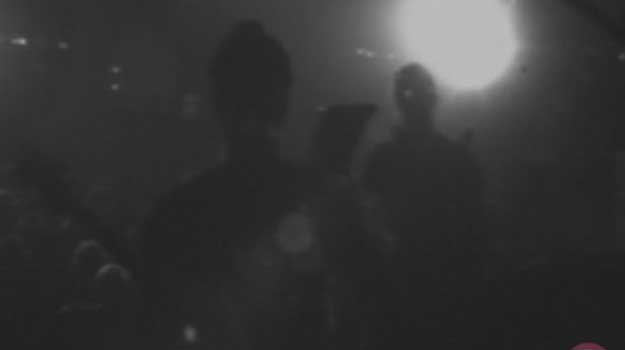
古斯塔夫‧阿道夫‧施羅德 Gustav-Adolf Schroeder 1981, 10:05mins
簡介/Synopsis
1980年代初,西柏林一方面是一個得到國家高額資助但文化氛圍相當無聊的城市;另一方面,另類文化正也在蓬勃發展。誰也不知道,這種文化將會往哪裡發展下去。就在這種混亂的局勢下,「大毀滅秀——天才業餘者節慶」於1981年9月4日在一個馬戲團的帳篷裡舉行了。這場事件後來成為近代音樂史中,德國龐克音樂的里程碑。
古斯塔夫‧阿道夫‧施羅德當時帶了一台老舊的攝影機,用黑白片記錄下了「倒塌中的新建築」樂團等的演出。他成功地在混亂和完美的舞步片段之間,拍攝深刻且具有歷史意義的畫面。
At the beginning of the 1980’s West-Berlin was, on the one hand, a city with a highly subsidised but rather boring cultural scene. On the other hand, an alternative scene was flourishing and no-one knew where it would lead to. Amidst this hurly-burly,“The Big Downfall Show – Festival of Genius Dilletantes”took place in a circus tent. The event went down in recent music history as a milestone in German punk music.
Gustav Adolf Schroeder was there with some old video gear and documented the appearance of the Einstürzenden Neubauten, among others, in black and white. He succeeded in getting impressive historical images somewhere between chaos and moments of perfect choreography.
﹉﹉﹉
ꕥ 作品介紹 33
辯論 Debatte
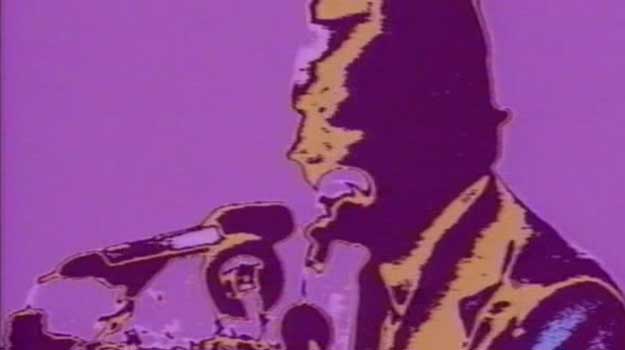
華特‧施羅德‧林姆 Walter Schröder-Limmer 1977/1978, 11:53mins
簡介/Synopsis
在華特‧施羅德‧林姆1977/1978年之「辯論」一作之中,我們可以看到在技術可能性上所做的觀念性的實驗手法。出現在影片中的是一些與「特勞勃竊聽案」相關的新聞節目之片段,此案最終讓當時的內政部長麥荷佛下台。在此他使用音效器和影像合成器抽象化聲音和圖像的軌跡:圓圈、橢圓和稜角,以及錯誤的顏色、減低色調、塗抹效果都被用到其中。獨特的影像拼貼於是形成,部分初始素材甚至已經被異化到認不出來。
Walter Schröder-Limmer’s work“Debatte”(Debate) from 1977/1978, conceptually keen to experiment, points to the technical possibilities inherent in video as a medium. It shows clips from news programmes dealing with the “Lauschaffäre Traube”, a scandal concerning surreptitious electronic surveillance which led to the involuntary resignation of the then Minister of the Interior, Maihofer. An audio effects device and a video synthesizer were used to abstract sound and image tracks: circles, ellipses and edges appear as well as miscolours, a reduction in tonal value and smudging effects. The result is a unique video collage in which the original material is, in parts, adulterated beyond recognition.
﹉﹉﹉
ꕥ 作品介紹 34
神奇的鏡子 Der Magische Spiegel
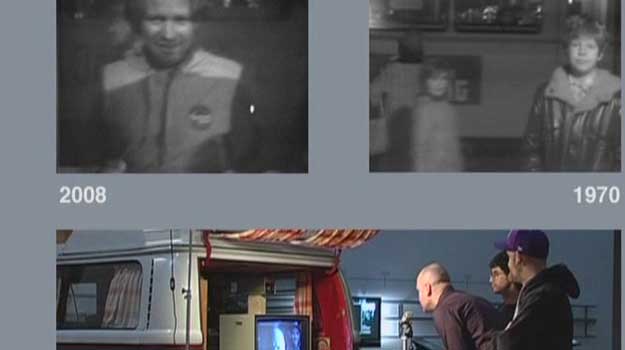
電視知識─錄影片 Telewissen-Video 1970/2008, 05:18mins
簡介/Synopsis
1971年12月,達姆施塔的行人徒步區上停著一輛福斯箱型車,從敞開著的後車廂門,行人看到一台電視在裡面。令他們吃驚的是,他們看到的竟是自己,這在當時是一件非常不尋常的事。
2007年以賀伯‧舒馬赫為核心的電視知識小組再一次上演了同樣的戲碼。他們用現代化設備,同1970年一樣,將當今觀眾們的反應記錄了下來。於是,他們將原來的素材、重新的製作以及重新上演的現場錄影片,組成一部紀錄片,不僅呈現了當年的作品,而且還展示40年之後觀眾「與攝影機互動行為」的改變。
In December 1971 a VW-Van was parked in the Darmstadt pedestrian precinct with its tailgate open so that passers-by were able to see a television-set. To their surprise, they saw themselves – in those days, a truly unusual occurrence.
This performance by the Gruppe Telewissen centred around Herbert Schuhmacher was reconstructed in 2007. Contemporary devices were used to record the reactions of today’s audience just like it happened in 1971. Out of the original materials, the remake and the recording of mounting the exhibition, a documentary emerged which doesn’t show the historical work alone but also changes in the audience’s ‘on-camera behaviour’ almost 40 years later.
﹉﹉﹉
ꕥ 作品介紹 35
魯爾區之旅─媒體屋 Medienhaus Ruhrtour
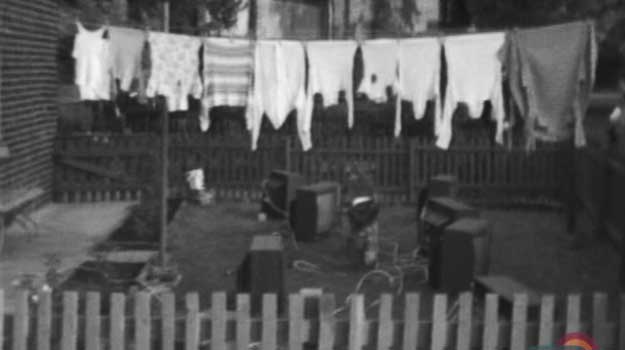
HA‧舒特 HA Schult 1978, 09:48mins
簡介/Synopsis
1978年HA‧舒特在為期14天的「魯爾區之旅」,幾乎每天都用一輛巴士載著他的觀眾們,駛向不同的目的地。其中一個地點「媒體屋」,是在杜伊斯堡的一座五口之家的住宅,到處扯滿了電線。HA‧舒特在屋前的小花園裡設置了9台電視,分別與屋內的攝像機相連。每個房間都安裝了攝像機,同步將屋內全家人的所有日常生活轉播到花園中,每個在花園中的人都可以看到這些影片。
舒特當時評論道:「這是一座把內部往外翻的房子」。但他肯定沒有預料到,他的想法在20年之後會衍生出「Big Brother」這類電視真人秀節目。
Almost every day for a fortnight in 1978, HA Schult drove his audience in a bus round his “Ruhrtour” to various destinations. One of them was the “Medienhaus” (Media House), a small wired-up workers’ home with a family of five in Duisburg Hamborn. HA Schult placed nine TV sets in the front garden, which were connected to cameras inside the house. They were installed in each room and transmitted the family’s everyday life simultaneously into the garden outside so that everyone could see it.
“A house turns itself inside-out” (own translation), as Schult commented at the time, without suspecting that 20 years later this concept would lead to the TV programme, “Big Brother”.
﹉﹉﹉
ꕥ 作品介紹 36
Interview Documenta
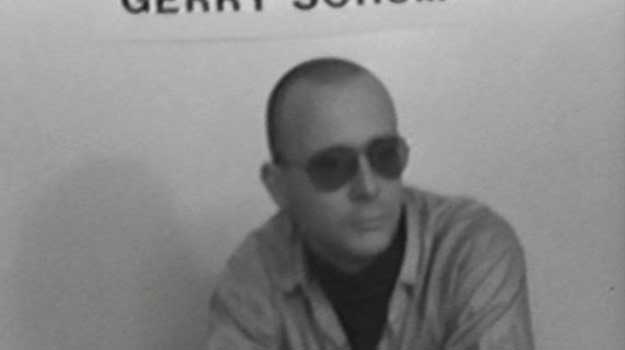
蓋瑞‧蘇姆 Gerry Schum – Interview Documenta 1972, 11:25mins
簡介/Synopsis
這是1972年在錄影藝術商蓋瑞‧蘇姆去世前一年的訪談,在訪談中談到了錄影藝術的樂觀前景,以及市場化即將到來的可能性。他比較「視頻」和「畫布」這兩種媒介,並解釋說,如繪畫一樣,視頻也允許對創作出的東西迅速地進行控制處理。對於他來說,錄影不是一種紀錄的技術,而是一種獨立的藝術形式。他提到像林克和呂科林這些與他合作過的藝術家,但這兩個人在蘇姆去世之後便不再從事錄像藝術了。
這恰恰證明了,蘇姆在德國扮演著怎樣一種孤寂的角色,而他也許只是比較早做出了正確的預言。
In this interview from 1972, one year before he died, the video gallery founder Gerry Schum, talks optimistically about video art and future possibilities for marketing it. He compares the medium of the “video system” to that of canvas, stating that video permits an immediate control over what one creates equalling that of painting. For him, video isn’t a technology of documentation, but rather an artform. He mentions artists such as Rinke and Rückriem, with whom he collaborated, but who turned away from the medium of video after Schum’s death.
It is just this that makes clear how much of a solitary role Schum played in Germany and how he had perhaps the right message – only before his time.
﹉﹉﹉
ꕥ 作品介紹 37
無題(燈的表演藝術) Untitled (Lamp Performance)
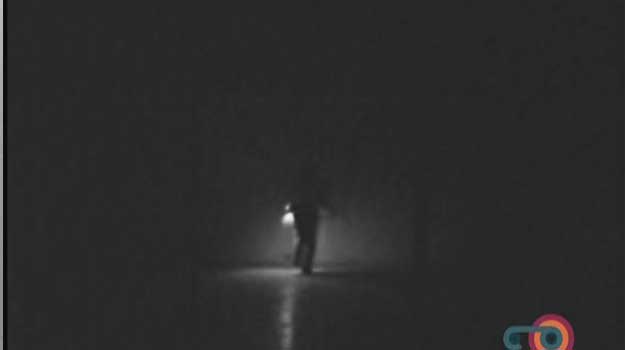
沃夫岡‧史托希勒 Wolfgang Stoerchle 1972, 02:31mins
簡介/Synopsis
沃夫岡‧史托希勒(1944-1976)16歲便隨父母移民北美,雖然他在歐洲幾乎沒有一點名氣,但在美國卻屬於上世紀70年代最重要的錄影藝術之先鋒。關於他的創作只有一個名為「1970年到1972年錄影選集」的錄影帶以及13部錄影短片保留下來。
其中一部我們看到的是史托希勒踏著響亮的步伐,穿過一個黑暗的大廳。只有一盞因走步而晃動的手電筒燈光,照明這個場景。走到大廳的盡頭後,他轉過身,走回到攝影機前。在手電筒的燈光中,他的臉變得越來越清晰,到最後他看起來像是被吸進了攝影機。
Wolfgang Stoerchle (1944–1976), who emigrated as a 16-year-old with his parents to North America, is hardly known in Europe, but in the 1970s he was one of the most important pioneers of video in the USA. Only a single tape with the title Selected Videos 1970–1972 remains, containing thirteen short pieces of work.
One of these shows Stoerchle traversing a dark hall, his steps echoing. The scene is lit only by the light of a torch swinging with his steps. Upon reaching the other side of the hall, he turns around and walks back towards the camera. His face becomes more and more visible in the torch light, finally appearing to be actually sucked into the camera.
﹉﹉﹉
ꕥ 作品介紹 38
姓名、外形、交換身分 Namen, Äußerlichkeiten, Personentausch
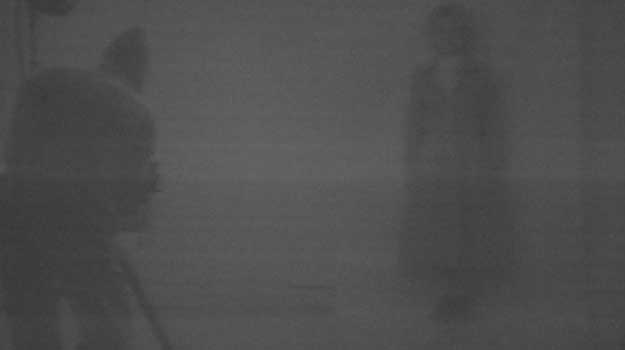
巫萊/烏威‧雷茲朋 Ulay/ Uwe Laysiepen 1975, 09:10mins
簡介/Synopsis
巫萊原名法蘭克‧烏威‧雷茲朋,1943年出生於在索林根。他在1975年錄影記錄,他最早的「光影圖像表演」創作之一。幽暗的空間之中,事實上是由紅光所照明,攝影機捕捉了隱約能夠分辨出站在攝影布幕背景前的一名女人。突然之間,閃光燈亮了一下。房間被瞬間照成了白色, 巫萊一身白衣出現,在畫上塗抹顯影劑。漸漸地,女人的陰影顯現出白色的輪廓,同時其他部分則為黑色。這個白色的輪廓區域跟巫萊的身形在片刻之間又合在一起,就好像他消失在他自己剛剛製作出的圖像裡一般。
Ulay, born as Frank Uwe Laysiepen in Solingen in 1943, documented one of his first photogramme performances on video in 1975. The space is darkened. In actual fact, it is illuminated with red light, so that the camera can make out the outline of a woman standing up against a photo screen. Suddenly a photoflash goes off. For a second, the space glows white. Ulay appears dressed completely in white and spreads developer fluid across the picture. The shadow of the woman slowly appears as a white outline, whilst everything else remains dark. In turn, Ulay fits himself for a moment into this white outline in such a way that he seems to disappear in his own, just produced picture.
﹉﹉﹉
ꕥ 作品介紹 39
一周縱覽 Wochenschau
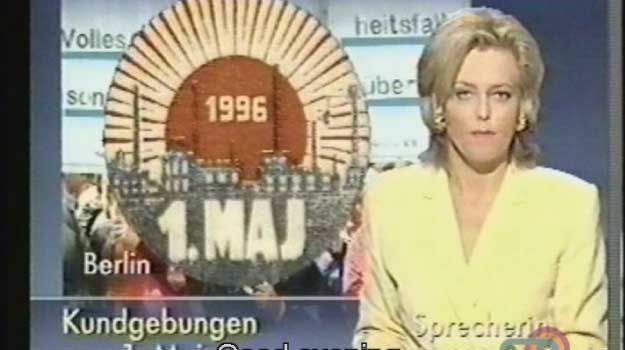
我們的電視台 / 漢斯‧克里斯提安‧丹尼 UTV / Hans Christian Dany 1995, 33:21mins
簡介/Synopsis
「我們的電視台」是1995年由漢斯‧克里斯提安‧丹尼、史蒂芬‧迪勒姆特和約瑟夫‧蔡勒一起在科隆成立的,他們是跟商業電視台相反的另類媒體計畫案,並以家用錄影系統之錄影帶的形式發行。
「一周縱覽 I」的主題是「工作和1996年5月1日」,其中我們看到一切關於此主題的綜合集錦,內容引人入勝,並且對今天一樣是具有時效性。電視新聞與劇情片的場景互相交替,自行製作的街頭採訪與黏土人偶動畫片交錯出現,短片從策劃好的小型縱火事件到巴黎索邦大學的課堂討論,再到嘻哈和繞舌音樂,最後所有這一切則在一個大派對中展演。
這是一個永遠都不可能上電視播放的節目。
The media project UTV–‘Our TV-Station’ was founded in 1995 by Hans-Christian Dany, Stephan Dillemuth and Joseph Zehrer as an alternative to commercial TV stations in Cologne and distributed on VHS tapes.
Around the topic of “Work and the 1st of May 1996”, the “Wochenschau I” (Weekly Review I) is a fascinating mix and still surprisingly current. TV news alternates with scenes from feature films, some street interviews with claymation films, seminars at the Sorbonne in Paris and items on hip-hop and rap follow small, staged acts of arson, and finally all of it is presented in one great party.
A TV programme the like of which would never be shown on TV.
﹉﹉﹉
ꕥ 作品介紹 40
文件大展的示範工具組 Demonstration / Demonstration Werksatz zur documenta
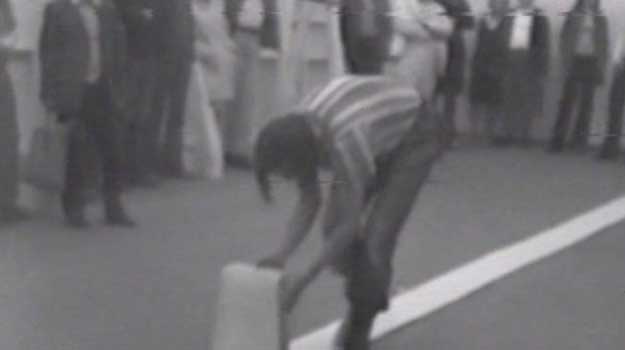
F. E. 華特─示範 F. E. Walther 1972, 23:54mins
簡介/Synopsis
一條有30個口袋、約10公尺長的布料上。法蘭茲‧艾爾哈‧華特會往每一個口袋裡鑽進去幾秒鐘。一開始他手裡還拿著一個錶,後來就沒拿了。他已經可以自己拿捏使用藝術作品的時間長短。不過在一場跟觀眾的對談中,他說這只是一個「可能的使用框架」。
這部紀錄短片是在1972年7月第五屆文件大展上所拍攝的。華特當時展示的是他如今聞名全球的作品「第一項工具組」。他每兩週去一次卡塞爾,為觀眾示範使用這套工具。最後他還認為:「我所講解的還是遠遠不夠的」。但其實正好相反,他是言簡意駭,也許對當時而言是太前衛了。
Some ten metres long, the strip of cloth has 30 pockets in it. Franz Erhard Walther slips into each for a few seconds. At first, he has a watch in his hand, then hasn’t. The sense of time for using the artwork has established itself. But this only indicates “a possible framework for use”, as he afterwards explains in talking to the public.
The documentation was recorded at the documenta 5 in July 1972. At it Walter showed his “1. Werksatz” (1.Template), today world-renowned, and he came to Kassel every two weeks to demonstrate his work to visitors. “What I said was nowhere near sufficient”, he declared at the end. The contrary is actually the case; it was simple and clear, but perhaps too much before its time.
﹉﹉﹉
ꕥ 作品介紹 41
把觀眾當作展品 Publikum als Exponat
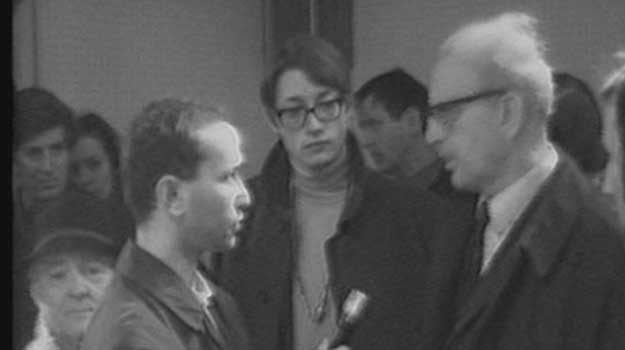
彼得‧威柏 Peter Weibel 1969, 17:48mins
簡介/Synopsis
「多媒體I」是歐洲最早的媒體藝術事件之一,1969年4月在維也納的「年輕的一代畫廊」舉行的。同時也是最早觀察觀眾的錄影紀錄之一。彼得‧威柏站在入口處,在攝影機前跟參觀者談論這個展覽,而且在幾台螢幕上同時出現現場的談話直播。
「把觀眾當作展品」的內容一方面是如此,同時另一方面,它也是第一位「實驗之夜」批判者,其中一次的談話就是以此為名。觀眾沉默的眼光也蠻有趣的,大家悄悄地試著控制自己在鏡頭前的模樣。
In April 1969, the Multi Media I one of the first media-art events in Europe, took place in the Viennese gallery, Junge Generation. And at the same time, it was one of the first staged observations of the public by video. Peter Weibel stood at the entrance and, in front of the camera, engaged visitors in conversations, which could be followed in parallel live on monitors, about the exhibition.
This is how “Das Publikum als Exponat” (The Public as Exhibit) saw itself on one hand, but also simultaneously as the first critic of the “experimental evening”, as it is called in one of the conversations. What is also interesting are the discrete glances of the people trying to check out their own appearance on the monitor unobtrusively.
﹉﹉﹉
ꕥ 作品介紹 42
橫向/縱向的跳躍 Horizontales/Vertikales Springen
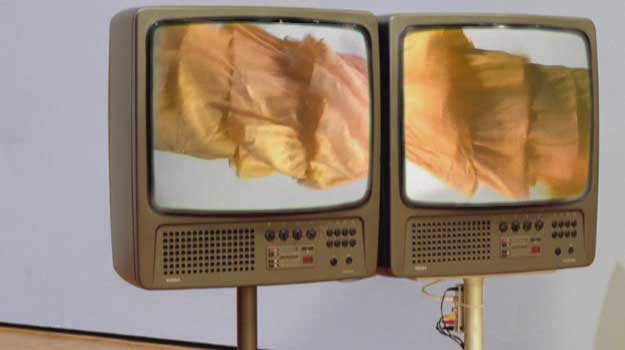
巫蘇拉‧薇菲絲 Ursula Wevers 1979, 12:29mins
簡介/Synopsis
巫蘇拉‧薇菲絲1979年的錄影片「橫向/縱向跳躍」讓人回憶起體育課或者遊樂場上的午後時光:只見一個人臀部以下的部分在彈簧墊上跳躍。時而橫向,時而縱向,有節奏地出現在由兩個左右並列在一起的螢幕所組成的畫面上。因為這場表演是在一塵不染的白色空間中發生,使得錄影的影像理想地符合白盒子的概念。
這部錄影短片不僅對平面與空間以及畫與雕塑等範疇進行實驗,而且還探討了新的藝術表達手段以及呈現的方式。
Ursula Wevers’ 1979 video,“Horizontales/Vertikales Springen” (Leaping horizontally and vertically) conjures up memories of your own sports classes or of afternoons on the playing field: you can see a person from the hips upwards, who is jumping on a trampoline. Now horizontally, now vertically, they appear rhythmically in the image-field, which materialises from two monitors set up alongside each other. At the same time, the video images ideally correspond to the notion of the white cube, as the performance happens in a sterile white space.
The video not only tests out categories like surface/space and image/sculpture, but also advocates new strategies of putting art across and of presenting it.
﹉﹉﹉
ꕥ 作品介紹 43
什麼都不是的國王 King Nothing
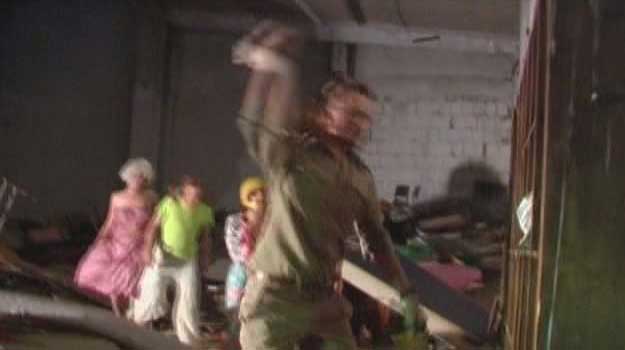
保羅‧威爾斯賓斯基 Paul Wiersbinski 2008, 05:56mins
簡介/Synopsis
畫面中出現這樣一幕:不知是一位策展人還是一名藝術家揮舞著鞭子,驅趕著一群收藏家,穿過破敗的大廳。他們飛快地從一件混亂的藝術品轉到另一件。畫面晃動,聲音也飛快。觀者幾乎什麼都無法明瞭。還好突然之間觀者會在螢幕上看到正式的英語字幕,從中得到最重要的信息。「這是不是萊比錫畫派?」觀者會常常看到這句話,因為如果不是萊比錫畫派的話,這件作品就完全沒有意義了。而且還不斷的出現「這個多少錢?」的問題。中間還出現很多藝壇使用的沒有意義的話,如「你必須跟藝術作品作溝通!」
藝術市場以及它裝腔作勢的一面被盡覽無遺,而且還很有娛樂的效果。
A curator, or an artist – we don’t know exactly – whips a gang of collectors through a dilapidated hall. At a breakneck pace, they rush from one chaotic artwork to the next. The image is compressed and the soundtrack is running too fast, there is scarcely anything understandable. Yet viewers get the most important points literally thrown at their heads as superimposed text in English. “Isn’t it Leipziger Schule?” can be read frequently. That’s because if not for that, it would be totally uninteresting. And again and again comes the question: “How much does it cost?” Between all that comes a lot of art business blather, such as: “You have to communicate with the art work!” The art market and its pretensions are unmasked and that’s a lot of fun.
 EXHIBITION
EXHIBITION
